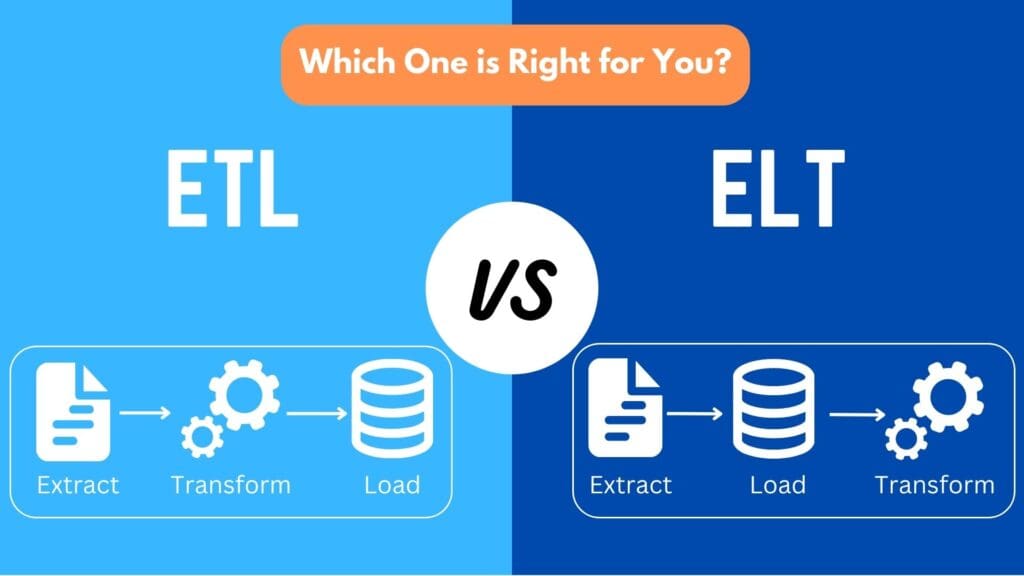ETL vs ELT: What’s the Difference and Which Should You Use?
Why ETL vs ELT Matters ?
In the world of data integration, two acronyms dominate: ETL (Extract, Transform, Load) and ELT (Extract, Load, Transform). While they sound similar, the differences between ETL and ELT can significantly impact your data architecture, performance, and scalability — especially as more teams move to the cloud.
In this post, we’ll break down:
- What ETL and ELT mean
- Key differences in approach and tools
- When to choose ETL vs ELT (with examples)

What Is ETL ?
ETL (Extract, Transform, Load) is a traditional data integration process where:
- Extract data from source systems
- Transform it (clean, map, filter, aggregate) in a staging environment or ETL tool
- Load the transformed data into a data warehouse or destination system
Example Use Case:
An on-premise system where data needs to be standardized before entering a tightly structured SQL Server data warehouse.
What is ELT ?
ELT (Extract, Load, Transform) reverses the last two steps:
- Extract data from source systems
- Load raw data directly into the cloud data warehouse
- Transform it inside the data warehouse using SQL or tools like dbt
Example Use Case:
A modern cloud data stack where raw data lands in BigQuery or Snowflake, and dbt models handle transformations later.
ETL vs ELT: Key Differences
| Feature | ETL | ELT |
|---|---|---|
| Transformation | Happens before loading | Happens after loading |
| Speed | Slower (pre-processing heavy) | Faster (load first) |
| Tool Examples | Informatica, Talend, SSIS | dbt, Fivetran, Airbyte + SQL |
| Ideal For | Legacy systems, compliance | Cloud-native data warehouses |
| Data Types | Structured only | Structured + semi-structured |
| Flexibility | Less flexible | Highly flexible (raw data stored) |
Why ELT Is Common In Cloud Architectures ?
Modern cloud data warehouses like Snowflake, BigQuery, and Redshift are optimized for ELT:
- They separate storage and compute, enabling massive parallel transformations
- They’re built to store raw, semi-structured data at scale (e.g., JSON, Parquet)
- Transformations can happen in-database using SQL, making the pipeline easier to manage and audit
When To Use ETL ?
ETL is still the right fit if:
- You need to enforce strict data quality before data enters the warehouse
- You operate in regulated industries where only clean data can be stored
- You use on-prem systems or legacy tools that don’t support ELT workflows
When to Use ELT ?
ELT works best when:
- You’re using a cloud-native data stack
- You want to store raw data for reprocessing or audit trails
- Your team uses dbt, SQL-based transformations, or event-driven pipelines
- You need to scale up transformations using cloud compute power
Choosing The Right Approach For Your Data Stack
Ask yourself:
- Is your data warehouse cloud-native?
- Do you need real-time or batch processing?
- Do your transformations depend on other business logic or need auditing?
Often, modern pipelines use a hybrid of ETL and ELT. For example:
- ETL for high-risk, regulated data
- ELT for fast ingestion and analytics
Conclusion: ETL or ELT?
Both ETL and ELT have their place. ETL is best for structured, controlled environments. ELT is ideal for scalable, agile analytics in the cloud era.
If you’re building on modern platforms like Snowflake or BigQuery, ELT is likely your future. But don’t ditch ETL where it still adds value.